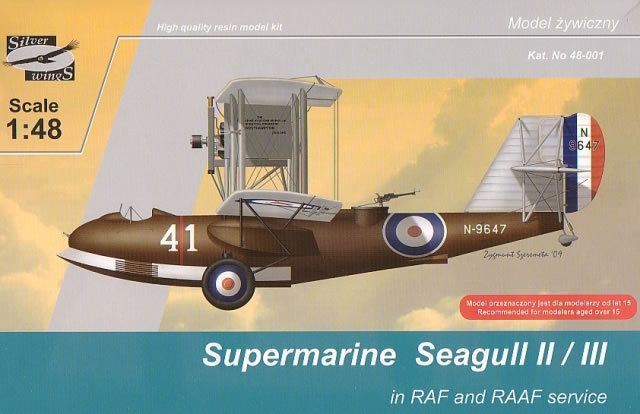Length 12 m | First flight May 1921 | |
 | ||
The Supermarine Seagull was a British amphibian biplane flying boat developed from the Supermarine Seal by the Supermarine company. The Seagull was constructed of wood. The lower wing was set in the shoulder position and had two bays. The engine was mounted in a nacelle slung from the upper wing and powered a four-blade propeller in tractor configuration. The fuselage had an oval cross-section and had a planing bottom with two steps.
Contents
Design and development
The prototype, which became known as the Seagull Mk I, was modified from an existing Supermarine Seal II in 1921. Only one aircraft was built. A Napier Lion II engine was fitted and there were modifications made to the nacelle.
Produced from 1922, the production aircraft, the Seagull Mk II, had a Napier Lion III engine, and these were supplied to the Air Ministry and Royal Navy. A total of 25 were built, although some of these were later modified.
The Seagull Mk III was the Australian version, built in 1925. These were similar to the Seagull II but with a Napier Lion V engine and radiators modified for tropical use. Six of these were supplied to the Royal Australian Air Force (or Navy? The Upper Hutt New Zealand City Library's "Recollect" collection has a photograph of a Seagull on HMAS Australia); one other Seagull III was built for Japan.
One Seagull II was rebuilt and fitted with Handley-Page leading edge slots and twin fins and rudders in 1928. This was considered to be the Mark IV, although Supermarine never designated it as such. Three ex-service aircraft were later placed on the British Civil Register.
In 1930 work was started on a flying boat of similar size and layout but with a predominantly metal airframe, powered by a Bristol Jupiter IX engine in pusher configuration. First flown in 1933 This became known as the Seagull V and later as the Walrus.
Operational history
The type was used operationally as a fleet spotter by 440 (Fleet Reconnaissance) Flight, operating from HMS Eagle. They were superseded in 1925 by the Fairey IIId. The Seagull II was the first British aircraft to be catapult launched in 1925. The crew was normally three (Pilot, Observer, and Radio-Operator). The sole armament was a .303 in (7.7 mm) Lewis gun.
Nine Seagulls were bought by the Royal Australian Airforce in 1926 and 1927. These were used to carry out a photographic survey of the Great Barrier Reef.
Operators
Surviving aircraft
Specifications (Seagull II)
Data from Supermarine Aircraft since 1914
General characteristics
Performance
Armament
Specifications (Seagull II)
Data from Thetford 1982, p.319
General characteristics
Performance
Armament
